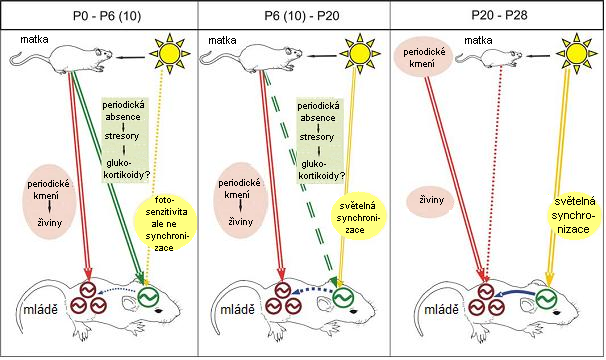The mammalian biological clock initiates its ontogenesis already during embryonic development in the maternal uterus. Newborn mammals are equipped with clock running in accordance with the maternal clock. We focus on investigating when and how do the newborn clock develop and entrain.
The entrainment of the clock is a complex process, whose mechanisms differ in successive developmental stages. We study these mechanisms in laboratory rat during its prenatal and postnatal development. We focus on the ontogenesis of the internal timing system as a whole, i.e. both the central clock in the brain and clocks in peripheral tissues.
Melatonin
A hormone secreted by the pineal gland in the brain. It is produced only during the nighttime, hence the nickname „the sleep hormone“. In the morning or shortly following the exposure to the light during the night, its level decreases rapidly

The entrainment of the embryonic clock
All the entraining cues are delivered to the embryonic clock exclusively from the mother’s body in the prenatal period.
The cues consist of complex rhythmic signals, such as hormones. The cues also depend on the maternal behavior. We can examine these mechanisms via manipulation of hormonal levels in pregnant dams (e.g. melatonin level) or by influencing the maternal behavior (e.g. exposure to the constant light or timing of the feeding regime).
The entrainment of the clock of newborn pups
After the delivery, external environmental factors start to participate in the entrainment of pups‘ clock and gradually replace the maternal signaling in full extent. The pups‘ biological clock continues to be entrained by maternal signals such as a regular care or breastfeeding in the first days after the delivery. During the following period, the central clocks in pups develop to be adjusted by external light conditions regardless of the mother and to control the peripheral clocks. Finally, the entire system controls the temporal organization of physiological processes. We use molecular biology techniques to study the embryonic, newborn and adult rat clocks at the level of clock gene regulation.
Practical applications
The human internal timing system is often disrupted in modern society, including pregnant women. The research of the circadian system during ontogenesis is crucial for understanding the connections between its developmental disruptions and various pathologies in adulthood. Our findings underline the importance of regular timing of sleep and food intake during development. They can be utilized in maternal care during (risk) pregnancy or in prematurely born infants care.
The internal timing system is entrained during ontogenesis by varying mechanisms. Prenatally, the embryonic clock is fully dependent on the maternal signaling. Postnatally, the central clock of pups gradually develops to be entrained by light and other external factors and to govern subordinate clocks in peripheral tissues (Sumová et al., 2006).










